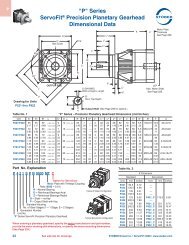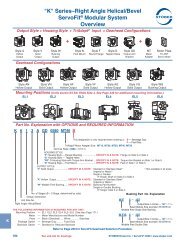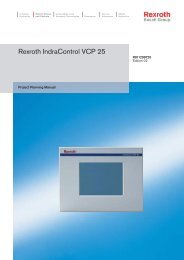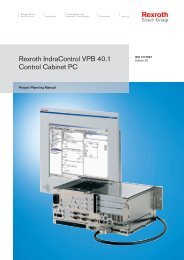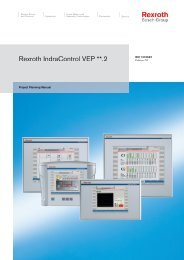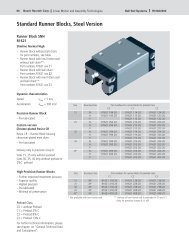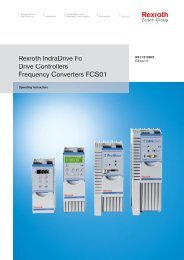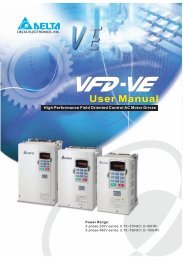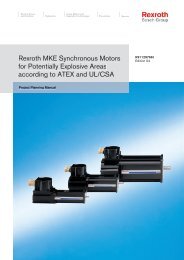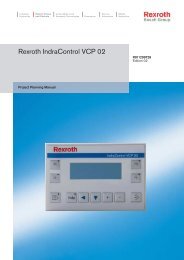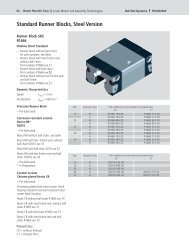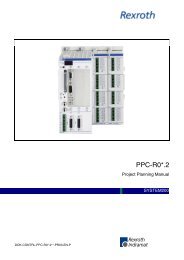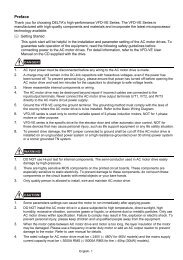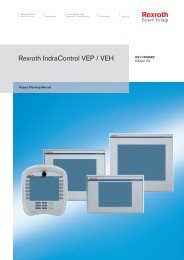You also want an ePaper? Increase the reach of your titles
YUMPU automatically turns print PDFs into web optimized ePapers that Google loves.
IndustrialHydraulicsElectric Drivesand ControlsLinear Motion andAssembly TechnologiesPneumaticsServiceAutomationMobileHydraulicsBall Rail TablesMaintenance <strong>Manual</strong>The Drive and Control CompanyMounting
1. Safety, Cross-References and Symbols 21.1 Safety notes and their symbols 21.2 Cross-referencing symbols 21.3 Symbols 22. Overview of Ball Rail Tables 32.1 Type Overview 32.2 Nameplate, Ordering of Spare Parts 32.3 Ordering of Components and Catalogs 33. Ball Rail Tables Fixings 43.1 Fixing the ball rail tables 43.2 Transport protection 44. Overview of accessories andattachments 55. Mounting the switching system 65.1 Mounting internal switches 65.2 Mounting external switches 65.3 Adjusting the switches 75.4 Mounting the socket 75.5 Mounting and dismantling the cable duct 86. Mounting the drive 96.1 Mounting the motor complete with motor mountand bellows coupling 96.2 Mounting the motor complete with motor mountand push-fit coupling 106.3 Dismantling a motor with motor mount 106.4 Mounting the motor with timing belt side drive 116.5 Dismantling the motor and timing belt side drive 127. Maintenance 138. Mounting assemblies and wear parts 148.1 Overview 148.2 Dismantling/mounting bellows 158.3 Replacing the fixed bearing 168.4 Replacing the floating bearing 178.5 Replacing the ball screw drive (BSD) 178.6 Replacing the sealing strip 178.7 Replacing the guide rail, carriage or base plate 179. Mounting X-Y tables 189.1 Mounting two ball rail tables of the same size(base plate on carriage) 199.2 Mounting a ball rail table of the next smaller size(base plate on carriage) 209.3 Mounting two ball rail tables of the same size(carriage to carriage) 209.4 Mounting a ball rail table of the next smaller size(carriage to carriage) 201. Safety, Cross-References and Symbols1.1 Safety notes and their symbolsThe following symbols are used to identify safety notes:DANGER !Risk of coming into contact with powerconductingparts! Cut off power supply!WARNING!Risk of injury!Caution!Risk of damage to Ball Rail Tableor adjoining structures!Caution!Keep Ball Rail Table clean!If necessary, cover it over!1.2 Cross-referencing symbolsThe symbols below are used to refer to repeat or follow-on workoperations:! 5.4 See Section 5.4! 5.4.2 See Figure 5.4.2(Figure 2 in Section 5.4)1.3 SymbolsuNote, recommendationScrew friction factor 0.125Strength class 8.8Tightening Torque2
303020 2020 2035 3530302. Overview of Ball RailTables2.1 Type OverviewBall rail tables are available in four sizesand in some cases in different heights. Forprecise data and dimensions, please referto the "Ball Rail Tables" Catalog.In the present document, only the ball railtables with ball screw drive (BSD) areillustrated.TKK 15 - 155 AlLTKK 20 - 225 Al, TKK 20 - 225 StLTKK 20 - 225 AlL22522515560105 75<strong>Bosch</strong> <strong>Rexroth</strong> Ball Rail Tables canbe mounted and maintained by suitablytrained technical personnel with the aidof this manual.TKK 30 - 325 Al, TKK 30 - 325 StL32590TKK 30 - 325 Al120TKK 35 - 455 AlL3251202.1L4552.2 Nameplate, Ordering ofSpare Parts1 Part number of ball rail table2 Serial number3 Date of manufacture• When ordering wear parts, pleasealways quote all the information on thenameplate.STARTYPID - NrDatumDeutsche Star GmbhD-97419 SchweinfurtTel. 09721/9370 - Fax 9373501460-305-0052278/306.02.1997STAR - matic1232.3 Ordering of Components andCatalogsTo order components, please refer to theCatalog for "Ball Rail Tables" or for"Controllers, Electrical Accessories".• These Catalogs supplement the currentinstructions and should therefore be kepthandy• Please order the latest publications fromyour local <strong>Bosch</strong> <strong>Rexroth</strong> sales partner.2.33
Aluminium version, secured from above3. Ball Rail Tables Fixings3.1 Fixing the ball rail tables1 Plug2 Base plate3 Reference edge4 T-nutBall rail tables made of profiled aluminumcan be fixed either… from above (! 3.1.1 )… or from below (! 3.1.2 ).Steel ball rail tables can be fixed only fromabove (! 3.1.3 ).In both versions, a reference edge is builtinto the base plate to help align the unit.The mounting plugs are supplied with theunit.The T-nuts are available as accessories.All connection dimensions are specified inthe "Ball Rail Tables" Catalog.Please also note the specialconnection system for ball rail tables: thissystem permits the assemblies to movealong several different axes.Tightening torques for the fixingscrewsfor friction factor 0.125strength class 8.8 /123r max. 0,33.1.1Aluminium version, secured from below123r max. 0,33.1.2 4Steel version, secured from above123ScrewM6 M8 M10 M16Torque in Nm 9,5 23 46 1953.1.3r max. 0,33.2 Transport protectionWarning! Before starting up thedrive, remove the protective transportpacking.3.34
Aluminum4. Overview of accessoriesand attachments8321• If required, the following componentscan be mounted ready for - operation.These Components may also be retrofittedat any time.Switching system1 Mechanical switches, external2 Cable duct3 Switching cam4 Proximity switch, external5 Socket/plug for external switches6 Profiled support7 Socket/plug for internal switches8 Mechanical and proximityswitches, internal77685544321Steel! 5.1099Drive9 Motor mount and coupling10 Motor11 Timing belt side drive4.1101110! 6.Mounting X-Y UnitsLast chapter of this manual4.25
225. Mounting the switchingsystem215.1 Mounting internal switchesAluminium version,mechanical switch (21)• Solder the cable to the switch• Screw the switch to the switch-plate• Hook the switch-plate into position• Lock the switch-plate in position withthe set screw.Aluminium version,proximity switch (22)• Screw the switch to the spacer plate• Screw the spacer plate to the switchplate• Hook the switch-plate into position• Lock the switch-plate in position withthe set screw.• To adjust the switch, slightly loosen thescrew fixing between the spacer plate andswitch plate and reset the switching distanceand then retighten.5.1.1Switching distances2,0 +0,2210,5 +0,22224Steel version,mechanical switch (23)• Solder the cable to the switch.• Screw the switch to the switch-plate.• Place the switch-plate on the base plate.• Clamp the switch-plate in position withthe set screw.23Steel version,proximity switch (24)• Screw the switch to the spacer plate.• Screw the spacer plate to the switchplate.• Place the switch-plate on the base plate.• Clamp the switch-plate in position withthe set screw.• To adjust the switch, slightly loosen thescrew fixing between the spacer plateand switch plate and reset the switchingdistance and then retighten.Switching distances2,0 +0,223 240,5 +0,25.1.26
5.2 Mounting external switchesAluminum version,mechanical switch (31)• Connect the cable to the switch.• Screw the switch to the switch-plate.• Hook the switch-plate into position.• Lock the switch-plate in position withthe set screw.• Adjust the switching distances byadjusting the switching cam.Aluminum version,proximity switch (32)• Screw the switch to the switch-plate.• Hook the switch-plate into position.• Lock the switch-plate in position withthe set screw.• Adjust the switching distances byadjusting the switching cam.5.2.13132Switching distances312,5 ±0,2320,4 +0,2Steel version,mechanical switch (33)• Connect the cable to the switch.• Screw the switch to the switch-plate• Fix the screw-plate to the profiledsupport with the T-nuts and screws.• Set the switching distances by adjustingthe switch.Steel version,proximity switch (34)• Screw the switch to the switch-plate.• Fix the screw-plate to the profiledsupport with the T-nuts and screws.• Set the switching distances by adjustingthe switch.5.2.23334Switching distances2,5 ±0,2 0,4 +0,2 33345.3 Adjusting the switchesWhen inner switches are shifted, theplastic sealing strip must be modified orreplaced.When outer switches are shifted, the cableduct must be modified or replaced. ! 5.5The cable of proximity switches cannotbe lengthened. The cables are molded intothe switch. If a proximity switch with longercable is required, we recommend that youbuy a new switch.5.37
5.4 Mounting the socketFor internally mounted switches:Internally mounted switches and socketsare supplied prewired. The deliverypack includes a plug with a pin layoutdiagram.• Solder the cable to the plug inaccordance with the pin layout diagram.• Check that the circuit operatescorrectly.To change internally mountedswitches or sockets ! 5.4.2externalinternalSocket and plug5.4.1For externally mounted switches! 5.4.3External sockets are supplied in kit formfor assembly. The pack includes two cableseals for fitting the cables in the socket.One of these seals is ready-drilled withthree holes designed for the cables of twomechanical switches and one proximityswitch.• If you have installed a different numberof switches, make the appropriate cableholes in the undrilled cable seal.• Thread all the cables through theclamping screw (1), cable seal (2),socket housing (3) and cork seal (4),taking care to use the appropriate plugconnection orifice (5) for yourinstallation.• Seal the unused orifice (6) in the sockethousing (3) with the O-ring (7) andblanking screw (8).• Solder the cables in the flanged socket(9). Prepare the pin layout diagram.Screw the flanged socket (9) firmly intothe socket housing (3) with the screws• Press the cable seal (2) into the housingwith the clamping screw (1).• Hook the complete socket assembly onto the ball rail table and lock it intoposition with set screws.• Mount the cable duct. ! 5.5• Solder the cables in the plug.• Check that the switch circuit functionscorrectly.5.4.25.4.3109543627188
5.5 Mounting and dismantlingthe cable ductThe cable duct can hold a maximumof two cables for mechanical switches andthree cables for proximity switches.Mounting the cable duct• Measure the length of cable duct required.• Cut the cable duct to the requiredlength and deburr.• Measure, punch-mark and drill thecable outlet holes.• If the existing fixing holes are notsufficient, drill additional fixing holes inthe base of the cable duct (Ø 3.1,depth 2.5).• Clip the cable duct into the groove onthe ball rail table and screw firmly intoplace. The 8 mm long M3 screws aresupplied with the duct. If required,8 mm long M3 set screws increase thefree space inside the cable duct.• Cut the cable grommets to theappropriate cable diameter and install.• Five cable grommets Ref. 8624-024-02are supplied.• Insert the cables and connect as required.5.5.19R 1,59,52412Mounting the duct cover withoutend-closure• Measure the length of the cable ductcover; cut to length and deburr.• Clip the cover into place.18 ±0,55300Mounting the duct cover with endclosure• Measure out the length of the cableduct cover.• Allow an extra 18 mm for each ductend-closure.• Cut the cover to length and deburr.• Remove ridges from the bending areaand from the end.• Bend the cover and clip into place.5.5.2Dismantling the cable duct• Lever open the end of the duct coverwith a screwdriver.• Lift the cover and turn it out of the duct.• Remove the cables.• Unscrew the fixing screws.• Lever the cable duct out of the groovein the ball rail table with a screwdriver.5.5.39
6. Mounting the drive6.1 Mounting the motorcomplete with motor mountand bellows couplingThe maximum torque andmaximum speed of the motor must notexceed the limits of the ball rail table!• Screw the motor mount to the ball railtable. Tightening torques ! 6.1.2• Insert the coupling.• Tighten the fixing screws of thecoupling at the end next to the ball railtable. Tightening torques ! 6.1.3• If necessary, to tighten the secondscrew, turn the BSD 180° or move thecarriage so that the BSD turns.• Place the motor in the centering bore ofthe motor mount and coupling andsecure firmly with four screws.Tightening torques ! 6.1.2• Tighten the fixing screws of thecoupling at the end next to the motor.Tightening torques ! 6.1.3• If necessary, to tighten the secondscrew, release the motor brake, turnthe BSD 180° or move the carriage sothat the BSD turns.Before using for the first time,check the EMERGENCY STOP switch!Run through the first operating cyclesat reduced speed in order to test theoperation of the limit switches and theinteraction of mechanical and electronicsystems.6.1.16.1.26.1.3M5 M6 M8 M10u (Nm) 5,5 9,5 23 46M5 M6 M8u (Nm) 8 13 306.2 Mounting the motorcomplete with motor mountand push-fit couplingThe maximum torque andmaximum speed of the motor must notexceed the limits of the ball rail table!A B• Fit one half of the coupling to the drivejournal of the ball rail table and the otherhalf to the drive journal of the motor.• Set distances A and B.• Tighten the screws of the couplinghalves with the tightening torquespecified in Table.• Fit the gear ring to one of the mountedcoupling halves.6.2.1TKK 15-155TKK 20-225A ± 0,1 (mm) B ± 0,1 (mm) u (Nm)VRDM 397VRDM 3910 18 4,5 10,5VRDM 391310
STARSTARSTARSTARSTARSTARSTARSTARMounting the motor complete withmotor mount and push-fit coupling(continuation)• Place the motor mount in the locatingrecess of the ball rail table and screwfirmly into place.6.2.2M5 M6 M8 M10u (Nm) 5,5 9,5 23 46• Align the motor so that the twocoupling halves fit into each other, andpress the coupling strongly together sothat the two halves join.• Align the motor with the centring boreof the motor mount and insert it intothe centring recess. Screw firmly intoplace.Before using for the first time,check the EMERGENCY STOP switch!Run through the first operating cyclesat reduced speed in order to test theoperation of the limit switches and theinteraction of mechanical and electronicsystems.6.2.3M5 M6 M8 M10u (Nm) 5,5 9,5 23 466.3 Dismantling a motor withmotor mountIf the ball rail table is mountedvertically or at an inclined angle, thecarriage must be prevented fromcrashing down!Disconnect from mains!• For the version with bellows couplingonly: loosen the fixing screws of thebellows coupling at the end next to themotor.• Unscrew the motor from the motormount and remove.6.311
6.4 Mounting the motor withtiming belt side driveThe maximum torque andmaximum speed of the motor must notexceed the limits of the ball rail table!Mounting the housing• Screw the housing of the timing beltside drive to the ball rail table.Tightening torques /Screw M6 M8 M10Torque in Nm 9.5 23 46Mounting the first belt pulley• Fit the belt pulley, complete withretaining ring, mounted timing belt andclamping assembly on to the journal ofthe ball rail table.• Set clearance A from the housing.A (mm)M…41…TKK 15-155 MMD 082 A9,5M…71… 11M…41…TKK 20-225 MMD 082 A9,5M…71… 11TKK 30-325 M…71… 11TKK 35-455M…71… 11,5M…90… 4,5A6.4.1Mounting clamping assembly Type 1Slightly oil the clamping elements.Do not use oil with MoS 2 additives!• Push on the clamping assembly andslightly tighten the screws. Align the hub• Tighten the screws evenly in diagonallyopposite sequence until all screws aretightened to the specified torque/Type 1Screw M4 M5 M6Torque in Nm 2.9 6 106.4.212
STARMounting clamping assembly Type 2• Slightly oil the clamping elements.Do not use oil with MoS 2 additives!• Push on the clamping assembly.• The clamping elements must be pushedall the way into the bore of the beltpulley.• Tighten the screws evenly in diagonallyopposite sequence until all screws aretightened to the specified torque /Type 2ScrewM2,5 M3 M4 M5Torque in Nm 1.2 2.1 4.9 9.76.4.3Mounting the second belt pulley andmotor with i=1• To ensure that the second pulley can bemounted without problem, the motormust first be premounted as close aspossible to the ball rail table.• Fit the belt pulley and clampingassembly to the motor journal.Set clearance B from the housing.• Mount the clamping assembly. ! 6.4.2or 6.4.3• Loosen the motor fixing.• Screw suitable screws into thepretensioning thread (2) provided ineach of the two motor strips (1).12/ FThe pretensioning force F dependson the sizes of the ball rail tables, motorsand belt pulleys and also on the torque.The rated pretensioning values arespecified on the inside of the gear cover. Ifthe timing belt side drive is not horizontalon assembly, the inherent weight of themotor must be taken into account!• Withdraw the motor with pretensioningforce F from the ball rail table andscrew in the fixing screws. Tighteningtorques /ScrewM5 M6 M8 M10Torque in Nm 5.5 9.5 23 46B (mm)M…41…TKK 15-155 MMD 082 A9M…71… 10M…41…TKK 20-225 MMD 082 A9M…71… 10TKK 30-325 M…71… 10TKK 35-455M…71… 10M…90… 3B6.4.413
Mounting the second pulley andmotor with i=1.5 or i=2• Fit the belt pulley and clampingassembly to the motor journal.• Set clearance C from the housing.Mount the clamping assembly. ! 6.4.2or 6.4.3• To ensure that the second pulley can bemounted without problem, premountthe motor as close as possible to theball rail table.• Do not tighten the motor fixing screws.Screw suitable screws into thepretensioning thread (2) provided ineach of the two motor strips (1).The pretensioning force F dependson the sizes of the ball rail tables, motorsand belt pulleys and also on the torque.The rated pretensioning values arespecified on the inside of the gear cover. Ifthe timing belt side drive is not horizontalon assembly, the inherent weight of themotor must be taken into account!• Withdraw the motor with pretensioningforce F from the ball rail table andscrew in the fixing screws. Tighteningtorques /C (mm)Mƒ 41ƒTKK 15-155 MMD 082 A16Mƒ 71ƒ 19Mƒ 41ƒTKK 20-225 MMD 082 A16Mƒ 71ƒ 19TKK 30-325 Mƒ 71ƒ 19TKK 35-455Mƒ 71ƒ 19Mƒ 90ƒ 21C1Screw M5 M6 M8 M10Torque in Nm 5.5 9.5 23 466.4.52/ FCompleting the installation• Fix all covers to the housing of thetiming belt side drive.Before using for the first time,check the EMERGENCY STOP switch!Run through the first operating cyclesat reduced speed in order to test theoperation of the limit switches and theinteraction of mechanical and electronicsystems.6.4.614
STARSTARSTARSTARSTARSTARSTARSTAR6.5 Dismantling the motor andtiming belt side driveIf the ball rail table is mountedvertically or at an inclined angle, thecarriage must be prevented fromcrashing down!Disconnect from mains!Remove the housing covers.The toothed timing belt ispretensioned. Caution is required whenloosening the motor fixing screws.• Push the motor as close as possible tothe ball rail table.• If the two belt pulleys are the samesize, loosen the lower clampingassembly.• Fully unscrew the motor fixing screws.Remove the motor.To dismantle the timing belt side driveplease take account of the differentinstallation variants. Threaded extractorholes are provided in the clampingassemblies to assist dismantling.6.515
7. MaintenanceBasic lubrication by the manufacturerhas reduced the maintenance requirementto relubricating the guide rails and of theball screw drives in accordance withoperating conditions.The fixed and floating bearings aregreased for life, and therefore undernormal operating conditions they do notneed to be relubricated.S1Lube nipplesLube nipple ports (S1) are located on bothsides of the carriage.• It is sufficient to lubricate on one side.S1Size of the lube nipplesTKK 15-155: DV1 - 6TKK 20-225, TKK 30-325, TKK 35-455:DIN 3405 AM 8x1LubricantsThe one-point lubrication system ofthe ball rail tables is only suitable forlubricating with grease!Greases containing solid lubricants(e.g. graphite and MoS 2 ) must not beused!The following lubricants are recommended:- lithium soap grease KP2K (DIN 51825)- consistency class NLGI 2 (DIN 51818)Lubrication intervalsUnder normal operating conditions:… Temperature 10 ƒ 30°C… Travel speed< 1 m/s… Load < C/2… Stroke> 80 mm… Speed of ball screw drive < 2500 rpmevery 0.5 to 1 . 10 5 m stroke travel or every500 operating hours, whichever is reachedfirst.• In the case of special operatingconditions (e.g. special installationtype, dust, solvents), the lubricationintervals must be adapted to theconditions of use.Lubricant quantitiesPer lubricating interval as a function of thesize and design of ball screw drive (BSD):see Table• When lubricating manually with thegrease-gun, measure out the quantityof grease per stroke.7.17.2Lubricant quantity per lubricating intervalSize BSD (d x P) Lubricant quantityTKK 15 - 155(g)16 x 10 3,716 x 16 3,820 x 5 4,520 x 20 6,520 x 5 5,720 x 20 7,7TKK20 - 225 25 x 5 6,425 x 10 7,725 x 25 11,0TKK 30 - 325TKK 35 - 45532 x 5 12,932 x 10 14,932 x 20 16,232 x 32 18,840 x 5 15,340 x 10 24,740 x 20 27,340 x 40 30,716
STARTYPID - NrDatumTKK 20- 255 278/307.07.1 95STAR - maticSTARSTARSTARSTAR8. Mounting assemblies and wear parts8.1 Overview31517Deutsche Star GmbhD-97419 SchweinfurtTel. 09721/9370 - Fax 9372752468.117
Item Component ForMG = Mounting GroupinstructionsWP = Wear Partsee Section1 MG Bellows 8.2WP Bellows "Fixings "2 MG Fixed bearing 8.3Fixed bearing block "WP Fixed bearing "Threaded ring "Slotted nut "Cheese-head screw / Straight pin "3 MG Floating bearing 8.4Floating bearing block "WP Ball bearing "Circlip "Cheese-head screw / Straight pin "4 MG Ball screw drive (BSD) 8.55 Threaded ring 8.56 MG Base plate 8.7Base plate "Ball rail system (guide rail) "7 MG Carriage 8.7Carriage "Ball rail system (guide rail) "Attachments "Please ask <strong>Bosch</strong> <strong>Rexroth</strong> for lists of wear parts.18
STARSTARSTARSTARSTARSTARSTARSTARSTARSTARSTARSTAR8.2 Dismantling/mountingbellowsDismantling the bellows:Disconnect from mains beforedismantling!• For ball rail tables with timing belt sidedrives, remove the covers of the sidedrive. ! 6.58.2.1• Unscrew the bellows from the bearingblock (1).• Remove the inner frame (2).2Do not tear the bellows!• Pull the bellows up to the carriage. Ifnecessary, grip from underneath withthe other hand.• Unscrew the bellows from the carriage (3).3• Remove the other inner frame.18.2.2Mounting the bellows• Fit the inner frame (4) in the first or lastfold so that one stiffening rib of thebellows is clamped with the frame.• Screw the bellows to the carriage (3).• Tightening torque for M4 screws:2 Nm. For M5: 3.8 Nm.• Insert the bellows at the fixed orfloating bearing end.• Hold the inner frame (2) firmly againstthe bearing block and screw to thebearing block (2). Tightening torque forM4 screws: 2 Nm. For M5: 3.8 Nm.48.2.319
STARSTARSTARSTARSTARSTARSTARSTAR8.3 Replacing the fixed bearingRemoving the bearing block togetherwith the fixed bearingIf the ball rail table is installedvertically or at an inclined angle, thecarriage must be prevented crashingdown!1• Move the carriage to its mid-position.Remove the motor. ! 6.3 or 6.5• Dismantle the bellows. ! 8.2If a plug is plugged into the bearingblock, disconnect it from the socket.• Loosen the socket locating set screw (1).• Unscrew the set screws (2) in theslotted nut.• Clamp the BSD screw in position. .Use plastic jaws!!• Unscrew the slotted nut (3).Remove the internally threaded straightpins (4).• Unscrew the cheese-head screws (5).• Remove the bearing block and fixedbearing carefully from the screw of theBSD, keeping them perfectly straight.4238.3.15Use plastic jaws!Removing the fixed bearing (angularcontact ball bearing) from thebearing blockFit plastic jaws to the vice.Clamp the bearing block in the vice.The screwed ring is fixed with Loctite 638.Use plastic jaws!• Heat the screwed ring with a hot airblower until the adhesive starts to runand the screwed ring can be loosened.• Unscrew and remove the screwed ringwith a ring wrench.8.3.2• Lay the bearing block flat on a supportwith a recess under the fixed bearing.Carefully push out the fixed bearing.8.3.320
STARSTARMounting the fixed bearing in thebearing block• Turn the block the other way up and layon a flat surface.• Insert the new fixed bearing carefully inthe bearing block as far as it will go. Donot skew the bearing and do not applyforce to the inner bearing ring!• Coat the threaded ring with Loctite 638adhesive and screw down firmly.LoctiteThreaded ring tightening torques:TKK 15-155 M45x1.5 28 NmTKK 20-225M45x1.5 28 NmM50x1.5 34 NmTKK 30-325 M55x1.5 52 NmTKK 35-455 M65x1.5 68 Nm8.3.4Mounting the bearing block andfixed bearing assembly• Push the bearing block withpremounted fixed bearing on to thescrew of the BSD.• Clamp the screw in position, usingplastic jaws.• Tighten the slotted nut (1) with threetimes the rated torque and thenreloosen and finally tighten with thespecified torque. This processpretensions the fixed bearing.• Fix the slotted nut with two set screwsUse plastic jaws!STAR STARTightening torquesSlotSetnut screwTKK 15-155 M12x1.0 8 Nm 2 NmTKK 20-225M12x1.0 8 Nm 2 NmM17x1.0 15 Nm 4 NmTKK 30-325 M20x1.0 18 Nm 4 NmTKK 35-455 M30x1.5 32 Nm 7 Nm8.3.521• Slightly tighten the cheese-head screws• Drive in the straight pins (4).• Tighten the cheese-head screws withthe specified tightening torque /STARSTARScrew M8 M12 M16Torque in Nm 23 80 19538.3.6421
STARSTAR8.4 Replacing the floatingbearingSTARRemoving the floating bearing• If necessary, dismantle the motor andtiming belt side drive. ! 6.5• Remove the bellows at the floatingbearing end. ! 8.2• If a socket and plug is mounted in thebearing block, remove the plug fromthe socket. Loosen the socket locatingset screw (1).• Move the carriage to about 20 mmfrom the floating bearing.• Remove the internally threaded straightpins (2).• Unscrew the cheese-head screws (3).8.4.132STAR1• Carefully remove the floating bearingblock. The bearings remain on the endof the screw. If fitted, the socketremains on the ball rail table.• Remove the circlips.• Pull the two bearings off the screw.Mounting the floating bearings8.4.2Do not oil the bearings and the endof the screw! Otherwise the bearingsmay slip in operation!STAR• Push both floating bearings on to theend of the screw and secure withcirclips.• Carefully push the bearing block overthe floating bearings.• Slightly tighten the cheese-head screws.• Drive in the straight pins.• Tighten the cheese-head screws withtightening torque / .STARSTARSTARScrew M8 M12 M16Torque in Nm 23 80 1958.4.322
STARSTARSTARSTARSTARSTARSTARSTAR8.5 Replacing the ball screwdrive (BSD)Dismantling the BSDDisconnect from the mains beforedismantling!If the ball rail table is installedvertically or at an inclined angle, thecarriage must be prevented fromcrashing down!The BSD may only be replacedcomplete with the nut. If the nut isremoved from the screw, balls will belost, causing the destruction of the BSD ifthe nut is remounted.8.5.1$• Remove the motor complete with motormount. ! 6.3 or 6.5• Remove the bellows. ! 8.2• Remove the fixed bearing block andfixed bearing. ! 8.3• Remove the floating bearing block andfloating bearings. ! 8.4The screwed ring is fixed with Loctite 638.STAR STAR• Heat the screwed ring with a hot airblower until the adhesive starts to runand the screwed ring can be loosened.• Unscrew and remove the screwed ringwith a ring wrench.8.5.2• Prepare V-shaped supports for thescrew with a recess for the nut.• Carefully pull the screw, complete withnut, out of the carriage.• Lay the screw on the V-shapedsupports.STAR STARDo not rest the screw on the nut!Significant bending of the screwindicates a danger of permanentdeformation!Longer screws (1500 mm andmore) should be supported or suspendedat several support points.8.5.323
STARSTARSTARSTARMounting the ball screw drive (BSD)• Insert the BSD nut into the carriage,with the lube hole (1) end first, slottingthe featherkey (2) into the keyway (3).3If the BSD nut is not inserted withthe lube hole (1) end first, it cannot belubricated during operation.• Carefully push the BSD nut and screwinto the carriage as far as they will go.Avoid impact.21In several installation variants ofthe ball rail tables, the nut must beturned 180° on the screw.A mounting sleeve is required for thispurpose and can be ordered togetherwith the replacement BSD.To turn the nut, please observe theassembly instructions for ball screwdrives. These assembly instructions arepacked with the replacement BSD.8.5.4• Coat the threaded ring with Loctite 638adhesive and tighten with a ring wrenchSTAR STARThreaded Ring tightening torques:TKK 15-155 M40x1,5 23 NmTKK 20-225M40x1,5 23 NmM45x1,5 28 NmTKK 30-325 M55x1,5 52 NmTKK 35-455 M78x2,0 80 Nm• Mount the bearing block and fixedbearing. ! 8.3• Mount the bearing block and floatingbearings. ! 8.4• Mount the bellows. ! 8.2• Mount the motor and motor mount orthe timing belt side drive. ! 6.1, 6.2or 6.48.5.5Loctite8.6 Replacing the sealing stripIf necessary, please refer to the MountingInstructions for the Rail Seal Cover Strip8.7 Replacing the guide rail,carriage or base plateTo ensure the precision of the ballrail table after replacing the guide rails,carriage or base plate, we recommendthat for these replacements you returnthe complete ball rail assembly to<strong>Bosch</strong> <strong>Rexroth</strong> Corporation.8.6 8.724
STARSTARSTARSTAR9. Mounting X-Y tablesX-axis9.1 Mounting two ball rail tablesof the same size (base plateon carriage)The attachments on X-Y tablesmust be mounted with care to ensurethey cannot be damaged!Note the desired direction ofinstallation. ! 9.1.19.1.1Y-axis1• Fix the cross-plate to the X-axiscarriage with screws (1) and pins (2).• Insert the straight pins (3) for locatingthe Y-axis base plate.3232• Insert and position four pairs of T-nuts(4) in the T-slots of the Y-axis base plate.Cross-plate• Place the Y-axis table on the cross-plateand lay it with the reference edge of thebase plate (5) on the locating pins (3).9.1.2• Fix the cross-plate from underneath tothe Y-axis base plate or to the readypositionedT-nuts using screws (6).• Move the Y-axis carriage away from thecross-plate zone by turning the BSD (7).• Remove the Y-axis bellows covering thecross-plate zone. ! 8.2• Fix the Y-axis base plate to the crossplatefrom above with screws (8) in thecorresponding threaded cross-plate holes.548• Drill holes in the Y-plate base platefrom underneath through the predrilledpin holes in the cross-plate(transfer the drill-hole pattern of thecross-plate to the base plate), deburrand fix with pins (9).9.1.39634369725
STARSTARSTARSTARX-axis9.2 Mounting a ball rail table ofthe next smaller size (baseplate on carriage)The attachments on X-Y tablesmust be mounted with care to ensurethey cannot be damaged!Y-axis• Drive straight pins (1) into the crossplatefor locating the Y-axis base plate.• Insert and position four pairs of T-nuts(2) in the T-slots of the Y-axis base plate.• Place the Y-axis table on the cross-plateand lay it with the reference edge ofthe base plate (3) on the locating pins (1).• Fix the cross-plate from underneath tothe Y-axis base plate or to the readypositionedT-nuts using screws (4).• Move the Y-axis carriage away from thecross-plate zone by turning the BSD (5).• Remove the Y-axis bellows covering thecross-plate zone. ! 8.2• Fix the Y-axis base plate from above tothe cross-plate with screws (6) in thecorresponding threaded cross-plate holes.• Drill holes in the Y-plate base platefrom underneath through the predrilledpin holes in the cross-plate(transfer the drill-hole pattern of thecross-plate to the base plate), deburrand fix with pins (7).9.2.19.2.23Cross-plate74211246758899• Note the desired direction ofinstallation. ! 9.2.1• Place the Y-axis table with mountedcross-plate on the carriage of theX-axis table.• Fix the cross-plate from above to theX-axis carriage with screws (8) and pins (9).9.2.326
X-axis9.3 Mounting two ball rail tablesof the same size (carriage tocarriage)The attachments on X-Y tablesmust be mounted with care to ensurethey cannot be damaged!• Note the desired direction ofinstallation. ! 9.3.1Y-axis9.3.1• Screw and pin the cross-plate to theX-axis carriage.Cross-plate9.3.2• Place the Y-axis ball rail table upsidedown on the cross-plate.• Screw and pin the cross-plate fromunderneath to the Y-axis carriage.9.3.327
X-axis9.4 Mounting a ball rail table ofthe next smaller size(carriage to carriage)The attachments on X-Y tablesmust be mounted with care to ensurethey cannot be damaged!• Note the desired direction ofinstallation. ! 9.4.1Y-axis9.4.1• Screw and pin the cross-plate to theY-axis carriage.Cross-plate9.4.2• Place the Y-axis ball rail table, completewith mounted cross-plate, upside downon the X-axis carriage.• Screw and pin the cross-plate fromabove to the X-axis carriage.9.4.328
<strong>Bosch</strong> <strong>Rexroth</strong> CorporationLinear Motion andAssembly Technologies14001 South Lakes DriveCharlotte, NC 28273Telephone (800) 438-5983Facsimile (704) 583-0523www.boschrexroth-us.com<strong>Bosch</strong> <strong>Rexroth</strong> CorporationCorporate Headquarters5150 Prairie Stone ParkwayHoffman Estates, IL 60192-3707Telephone (847) 645-3600Facsimile (847) 645-6201<strong>Bosch</strong> <strong>Rexroth</strong> CorporationIndustrial Hydraulics2315 City Line RoadBethlehem, PA 18017-2131Telephone (610) 694-8300Facsimile (610) 694-8467<strong>Bosch</strong> <strong>Rexroth</strong> CorporationElectric Drives and Controls5150 Prairie Stone ParkwayHoffman Estates, IL 60192-3707Telephone (847) 645-3600Facsimile (847) 645-6201<strong>Bosch</strong> <strong>Rexroth</strong> CorporationPneumatics1953 Mercer RoadLexington, KY 40511-1021Telephone (859) 254-8031Facsimile (859) 281-3491<strong>Bosch</strong> <strong>Rexroth</strong> CorporationMobile Hydraulics1700 Old Mansfield RoadWooster, OH 44691-0394Telephone (330) 263-3300Facsimile (330) 263-3333RE 82 751



